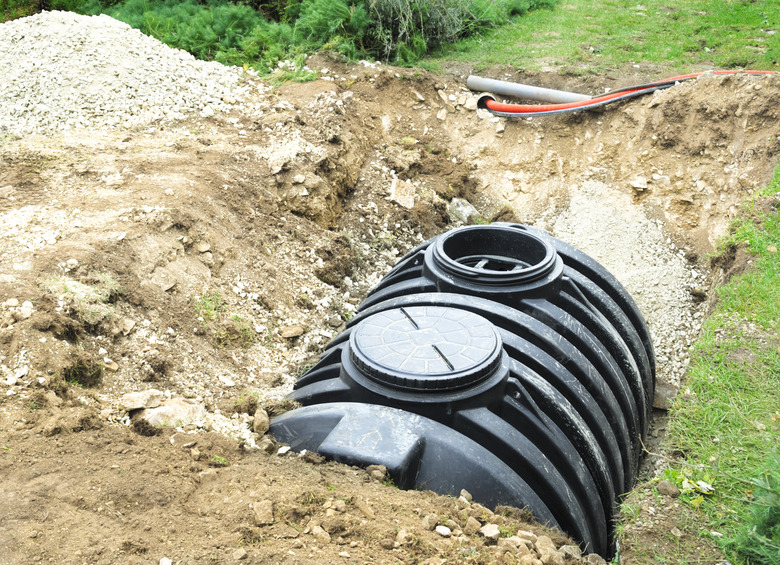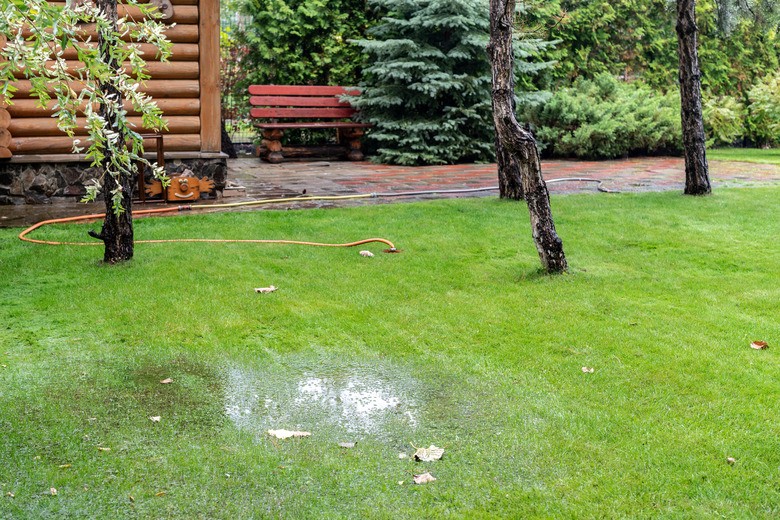How To Find My Septic Tank Lines
Wondering where your septic lines run? Locating the septic tank on a property is important for properly maintaining and protecting the system. You don't want to pave over the area or plant trees too closely, for example. If you can get your hands on the septic tank diagram of the drain field, you have a good idea of where the pipes run. If not, you may need to try some other techniques for finding septic drain lines.
Septic System Basics
Septic System Basics
A septic system consists of a tank to hold solids and the leach field that drains the liquids. A baffle or wall inside the tank separates the solids from the liquids. The liquids disperse into the ground by a drain line that connects to perforated pipes dug into trenches and laid on a bed of gravel, where the liquids are absorbed by the soil. Issues occur when pipes are blocked or drain fields become too saturated with liquid. Other problems include improper location, design flaws or poor installation.
Locating a Septic Tank on Your Property
Locating a Septic Tank on Your Property
Start your search for the septic tank lines at the house. Trace the plumbing drain lines to the septic tank, which is usually installed 10 to 20 feet from the home's exterior. At the tank's end opposite the house, the drain line leads to the leach field.
Check the natural slope of the land to locate the leach field. When searching for drain lines, never use heavy machinery, wrecking bars or jackhammers. Call your local electric utility provider or gas company to locate buried gas or utility lines before digging. A septic tank probe can also help you find the location. Stick the long, thin metal probe into the ground until you feel it hit the tank and feel the edges of the tank. That can help you find the pipes leading away from the tank.
Perform Regular Inspection
Perform Regular Inspection
Professionals recommend that you inspect septic tanks and, if necessary, pump them out every three years. If you have issues with gurgling sounds in your home or water backing up after the system is serviced, the cause could be a saturated drain field. Water logged or compromised drain fields cannot be repaired. You'll need a new drain field constructed for the septic system to work again.
Check for Clean-Outs
Check for Clean-Outs
Look for capped clean-outs that sit vertically above the ground a few inches in the leach field itself, or look behind a wall or in a closet in the basement. The clean-outs let you check the liquid level in the drain field line when it is open. If you have no other information, visually trace the orientation of the pipe from the clean-out. Some drain fields have clean-outs at the beginning and end of the leach field.
Spot Natural Indicators
Spot Natural Indicators
A wet or swampy area that never dries could be a sign of the septic drain lines. Grass or vegetation that greens in stripes when grass around it browns can also help you spot the lines. Lack of snow or frost in a specific area during the winter may be another telltale sign. If you run hot water into your system, it can cause snow or frost to melt above the drain lines.
Look for shallow depressions running parallel to each other that mark drain field trenches. If you have a deep system, which is the case for homes with basements, you probably won't be able to see natural indicators because the drain field is too deep. But if you smell a foul odor, the system is likely in need of maintenance, regardless of how deep it is.
View System Drawings
View System Drawings
The blueprint or drawings for septic system installations are on file with the local health department, as long as the system was built with a permit. The location, layout, components and any other details of the drain field are usually found on the septic tank lateral lines diagram.
If your search doesn't turn up any relevant results, request a record search on your street address or the tax account number for the property. Fill out a "Request for Copy of Septic System Drawing" form, and submit it to your local health department. If they have the record, the agency will mail it to you. If that fails, contact the previous owner of the home.
Get Professional Help
Get Professional Help
Enlist the help of a disposal system contractor or a licensed liquid waste hauler to locate the septic system if you don't have a drawing. The search typically focuses on the septic tank first and then the layout of the drain field lines. You can also pick up a flushable transmitter from a plumbing or rental store or a tank cleaning company. Once the transmitter flushes down the toilet, a hand-held receiver picks up its signal.
Check the Distribution Box
Check the Distribution Box
Some septic tanks have an additional distribution box a few feet from the tank on its downstream side. The box channels water into the trenches via ports and pipes. If your system has a distribution box, it should have a lid that reveals the direction of the ports that lead to the drain field lines. It's possible to locate the box with a probe, but be careful. Don't use excessive force with the probe that may cause damage to the box.
Know the Size and Scope
Know the Size and Scope
The size and scope of your drain field depends on your home and the type of soil you have. The drain line exits the tank parallel to the intake, but individual drain lines may run perpendicular to the intake line or fork into an H-pattern or other patterns that fit the land. The lines should not be closer than 10-feet apart and no longer than about 100-feet long.
A little detective work can help you find your septic drain lines so you can protect the area around them. Start poking around your yard, or enlist the help of a pro to find and service your septic system.
References
- British Columbia Ministry of Environment: How to Find a Septic Tank
- The Engineering Toolbox: Septic Systems
- Thurston County Washington Public Health and Social Services: Locate Your Drainfield
- Washington Department of Health: Do-It-Yourself Septic System Inspection Field Guide (Gravity System)
- Mr. Rooter: How to Find Your Septic Tank

